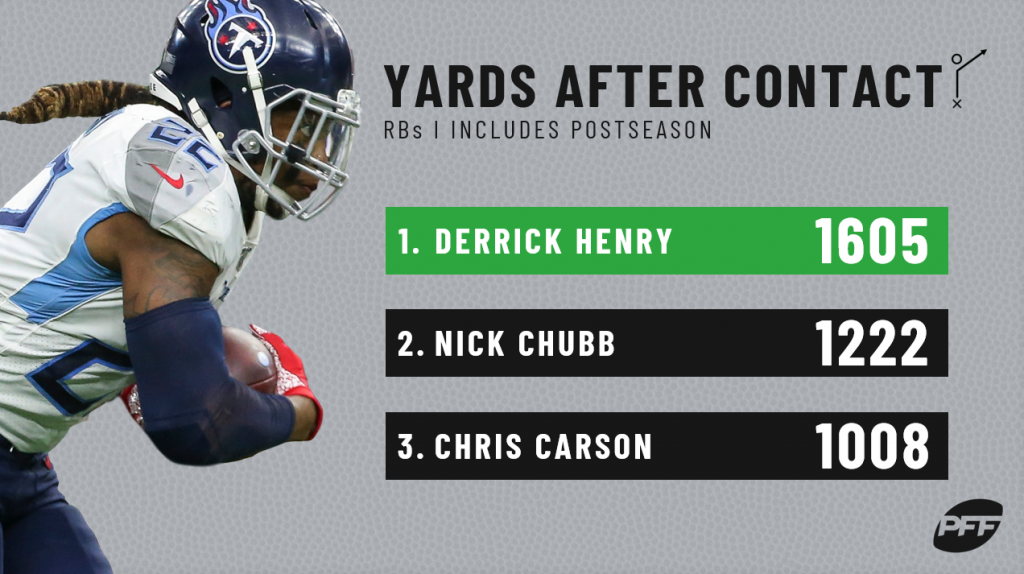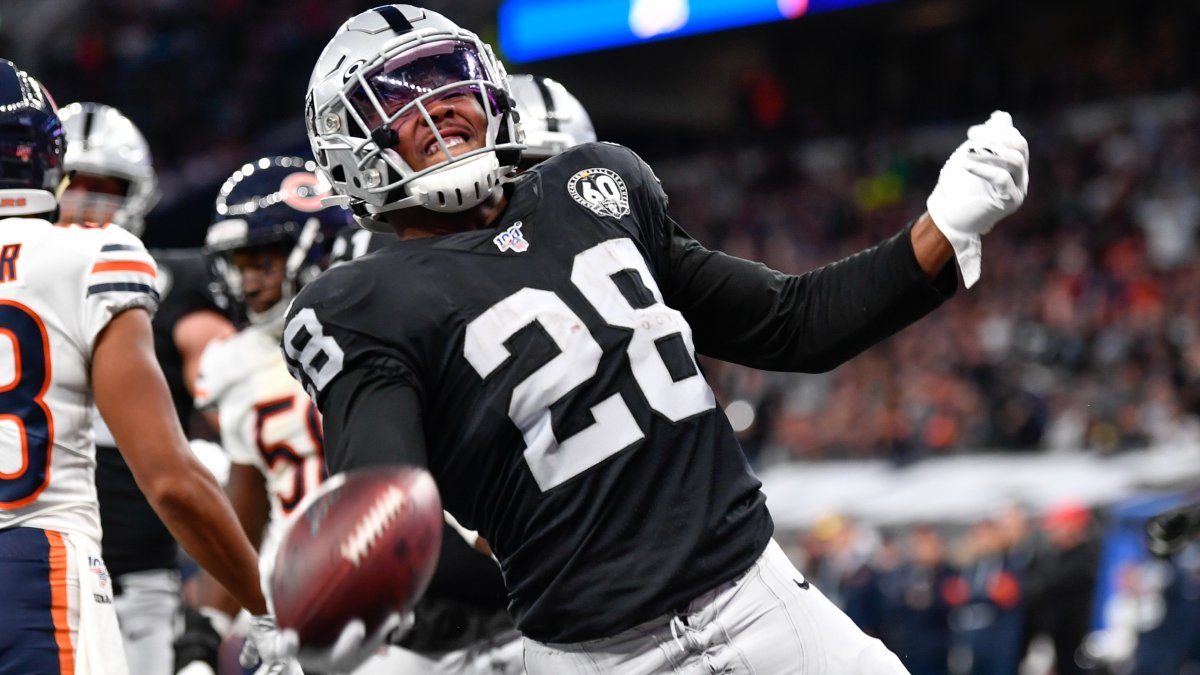PFF's in-depth charting and advanced stats look beyond the box score to identify key metrics otherwise overlooked across all positions in the NFL. This “Signature Stat Spotlight” series will walk readers through the varying advanced stats and metrics we track for every player at every position in every game.
[Editor’s Note: To dive into PFF’s grading system and Premium Stats 2.0, subscribe to PFF’s ELITE – Monthly or ELITE – Annual subscription.]
Below is a deep dive into the running back position. In addition to grading all of the NFL’s running backs via our advanced grading process, PFF tracks forced missed tackles, yards after contact, elusive rating and breakaway percentage in Premium Stats 2.0, our advanced statistics database made available to all of our ELITE subscribers. I’ll also highlight some advanced stats we can pull from other sources behind the scenes at PFF that we sometimes reference in articles.
Signature Stat Spotlight Series:
QB | RB | WR | TE | OL | DL | LB | CB | S
PFF Elusive Rating, Yards After Contact and Forced Missed Tackles
PFF Elusive Rating, which pulls carries, receptions, forced missed tackles and yards after contact into a formula to calculate a rating similar to passer rating, is meant to illustrate a running back’s elusiveness in a singular number. The formula: (Forced Missed Tackles) / (Carries + Receptions) * (Yards After Contact per Attempt * 100).
Among the 51 NFL running backs with at least 100 total touches (rush attempts + receptions), Dallas Cowboys rookie running back Tony Pollard ranked first in PFF Elusive Rating at 116.1. He forced 26 missed tackles and averaged 4.51 yards after contact per rush attempt across his 101 touches in 2019. Fellow rookie Josh Jacobs ranked second among the same group of qualifiers in PFF Elusive Rating at 103.6. The Oakland Raiders phenom forced 78 missed tackles and averaged 3.48 yards after contact per rush attempt in 2019.
zeke pollard earning his $90Mpic.twitter.com/gNi73di1Sj
— Austin Gayle (@PFF_AustinGayle) October 21, 2019
Tennessee Titans’ Derrick Henry led all running backs with at least 100 rush attempts in yards after contact per attempt (4.18) in 2019. Cleveland Browns’ Nick Chubb (3.77) and Houston Texans’ Duke Johnson (3.64) finished second and third on the list, respectively. Henry also totaled nearly 400 more yards after contact than any other back in the NFL this past season.

Jacobs beat out Henry, Pollard, Chubb and the rest of the NFL in forced missed tackles per touch at 0.30. Arizona Cardinals running back David Johnson finished dead last in forced missed tackles per touch (0.08) and averaged just 2.05 yards after contact per attempt in 2019. Only Chicago Bears’ Tarik Cohen (1.94) recorded a lower yards after contact per attempt average. Johnson also ranked last in PFF Elusive Rating in 2019 at 17.4.
Breakaway Percentage
When a running back gains 15-plus yards on a single run, PFF tracks the run as a breakaway run and all the yards gained as breakaway yards. Then, PFF divides all of the running back’s breakaway yards by their total yards to calculate a back’s breakaway percentage and show which runners earn the highest (and lowest) percentage of yards on big runs.
San Francisco 49ers running back Matt Breida led all running backs in breakaway percentage, or percentage of rushing yards gained on runs of 15-plus yards at 42.4%. Minnesota Vikings running back Alexander Mattison ranked second at 41.3%. The lowest-ranked back in breakaway percentage in 2019 was New York Jets veteran Le’Veon Bell at 4.3%. No other running back in football finished below 5% in 2019.
Breida's teammate, Raheem Mostert, led all qualifying backs in percentage of carries that resulted in a gain of 15-plus rushing yards at 10.37%. Denver Broncos‘ Royce Freeman had the lowest percentage of carries that resulted in a gain of 15-plus yards at 0.76%.
Running Back Receiving Metrics
In today’s NFL, catching the ball is just as important if not more important for running backs, so we also track receiving success for backs using the same advanced stats for tight ends and wide receivers (i.e., yards per route run, passer rating when targeted, YAC/reception, drop rate). We track yards after contact and forced missed tackles on receptions for all pass-catchers, as well.
Among the 19 NFL backs with at least 50 total targets in 2019, Vikings veteran back Dalvin Cook ranked first in yards after the catch per reception at 11.3. Cohen ranked last among the same group of qualifiers at 5.6.
Los Angeles Chargers running back Austin Ekeler not only led all at his position in PFF receiving grade (93.6), but he also led all qualifying backs in passer rating when targeted at 124.1. Ekeler caught 92-of-104 targets for 993 yards and eight touchdowns in 2019. He also dropped just two passes all season and led all qualifying running backs in yards per route run (2.74).
looking forward to austin ekeler's holdout pic.twitter.com/fYXtVS2XLz
— Austin Gayle (@PFF_AustinGayle) October 20, 2019
Running Back Pass-Blocking Metrics
Baltimore Ravens running back Mark Ingram II was the only one at his position to record 50-plus pass-blocking snaps and zero pressures allowed in 2019. Among the 21 NFL backs with at least 50 pass-blocking snaps this past season, Ingram ranked first in pass-blocking efficiency (100.0) with his zero pressured allowed across 51 pass-blocking snaps.
On the opposite end of the spectrum, Jacksonville Jaguars’ Leonard Fournette allowed 14 pressures across his 78 pass-blocking snaps and ranked last among qualifiers at his position in PFF pass-blocking efficiency (89.7) as a result.
[Editor’s Note: To dive into PFF’s grading system and Premium Stats 2.0, subscribe to PFF’s ELITE – Monthly or ELITE – Annual subscription.]
In addition to advanced stats shown in Premium Stats 2.0, we chart intended point of attack, the actual point of attack, yards before first contact and run concept (i.e., power, outside zone, inside zone).
PFF’s point of attack charting can reveal back’s both at the NFL and college level who tend to bounce runs away from the intended hole for the play. Yards before first contact is a great figure to take into account when evaluating a running back’s vision and the success of the offensive line ahead of him.
Breida led all NFL backs with at least 100 total attempts in yards before first contact per attempt at 2.29. Conversely, Bell ranked dead last among the 45 backs at 0.56.
To continue to learn more about PFF’s advanced stats, please stay tuned for the rest of our Signature Stat Spotlight Series. Or, better yet, subscribe to PFF’s ELITE subscription to dive into the numbers yourself throughout the offseason and into next season.
Signature Stat Spotlight Series:



 © 2025 PFF - all rights reserved.
© 2025 PFF - all rights reserved.